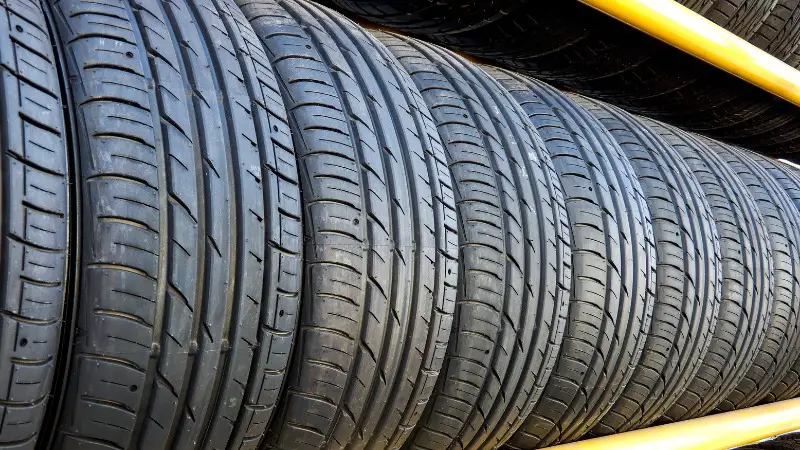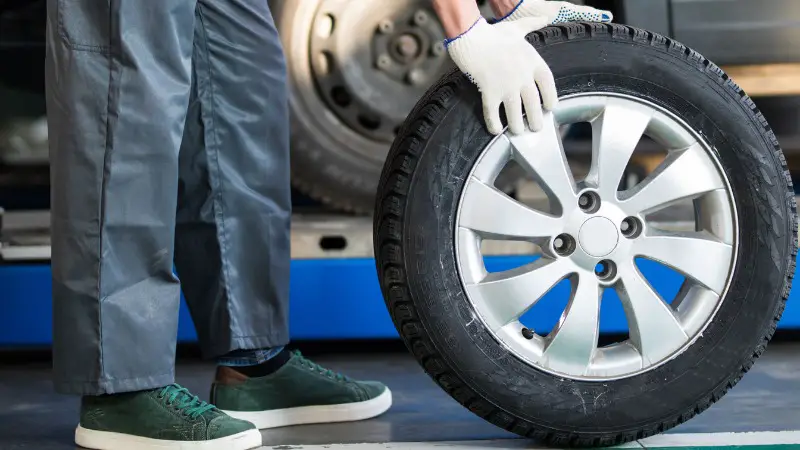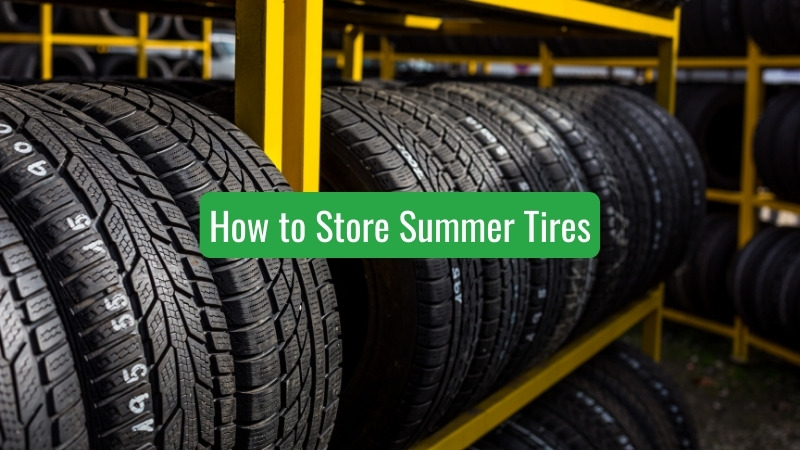As seasons change, so do your tire needs, and knowing how to properly store your summer tires is essential to extend their life and maintain optimal performance.
This guide will provide you with expert tips and best practices to ensure your tires remain in excellent condition throughout the off-season.
Summer tires are designed to perform best in warm weather conditions, offering enhanced traction and handling on both wet and dry roads. However, as temperatures drop, they become less effective and potentially unsafe for winter driving.
By correctly storing your summer tires during the colder months, you’ll be ready to switch back to them when the weather warms up, ultimately saving you time and money in the long run.
Why Storing Summer Tires Matters
Properly storing your summer tires is crucial for preserving their lifespan and performance. Exposure to extreme temperatures, direct sunlight, and moisture can degrade the rubber and reduce the effectiveness of your tires when you need them most.
When you store your summer tires properly, you’re maintaining their structural integrity and minimizing wear. This not only helps ensure your tires are ready to perform when you need to use them again but also saves you money in the long run by extending their life and reducing the need for frequent tire replacement.
Another reason for proper storage is to prevent environmental damage. UV radiation and heat from direct sunlight can cause oxidation and deterioration of the rubber compounds in your tires.
Moreover, exposure to moisture may result in the development of mold and mildew, which can weaken the structure and compromise their performance.
Besides protecting your tires, proper storage also helps maintain the cleanliness of the space where your tires are stored.
Covering your tires and storing them off the ground can safeguard your garage or storage area from dirt, debris, and possible staining.
To sum up, storing your summer tires correctly is essential for their longevity, performance, and the cleanliness of your storage area.
In the following sections, we’ll provide practical tips and guidance on how to carefully store your summer tires for optimal protection.
Choosing the Right Storage Location

When it comes to storing your summer tires, selecting the appropriate storage location is crucial for preserving their condition and performance.
Below, we will explore the benefits and considerations of both indoor and outdoor storage options.
Indoor Storage
Indoor storage is the recommended choice for protecting your tires from the elements.
You should look for a clean, cool, and dark location away from direct sunlight, heat sources, and ozone generators such as hot pipes or electric devices. Common indoor storage spaces include basements, garages, and storage units.
When storing your tires indoors, consider the following tips:
- Ensure the area is clean and free of dust, chemicals, and sharp objects that may damage the tires.
- Make sure the space is well-ventilated to prevent moisture buildup.
- Stack tires horizontally or hang them vertically to save space and protect their shape.
- Avoid storing tires near windows or other areas exposed to sunlight, as UV rays can cause rubber degradation.
- Keep the tires away from electrical devices and heat sources, as they can generate ozone that leads to rubber deterioration.
Outdoor Storage
Outdoor storage is typically recommended for short periods of time, as it comes with more exposure to weather and temperature fluctuations. However, if outdoor storage is your only option, you can still take steps to protect your tires.
When storing your tires outdoors, keep these recommendations in mind:
- Raise the tires off the ground using pallets, racks, or other supports to prevent moisture buildup and direct contact with the ground.
- Cover your tires with a waterproof, breathable tarp or tire storage bag with air holes to allow for proper ventilation.
- Choose a shaded area, if possible, to minimize exposure to sunlight and reduce the risk of rubber degradation.
- Ensure the storage site is secure and away from potentially destructive wildlife or pests.
By carefully considering these storage options and choosing the one that best suits your situation, you will help prolong the life of your summer tires and maintain their performance.
Preparing Your Tires for Storage
Before storing your summer tires, it’s essential to prepare them properly to ensure they remain in good condition throughout the storage period. This involves cleaning and drying your tires and inspecting them for any damage.
Clean and Dry Your Tires
First, thoroughly clean your tires to remove any dirt, dust, and debris that may have accumulated. You can use a mild soap and water solution along with a scrub brush to clean the tire surfaces.
Be sure to give attention to the sidewalls and tread areas. After cleaning, rinse the tires with water and allow them to dry completely before proceeding to the next step.
Drying your tires is crucial as moisture can lead to corrosion or mold growth while in storage.
Inspect for Damage
Before storing your tires, it’s important to inspect them for any signs of damage, such as cuts, punctures, or cracks. If you find any damage, it may be necessary to repair or replace the affected tire before storing it.
Additionally, be sure to check the tread depth on each tire to determine if they are still safe to use for the next season. If the tread depth is below 2/32 of an inch, it’s time to replace the tire.
By properly preparing your tires for storage, you can maintain their quality and ensure they are ready to use when the next summer season arrives.
Proper Storage Techniques
When it comes to storing your summer tires, it’s essential to follow proper storage techniques to ensure their longevity and maintain their performance. This section will discuss three common methods: Stacking, Hanging, and Storing in Bags.
Stacking
Stacking tires is a popular option, as it allows for efficient use of available space. To stack tires effectively:
- Stand them upright
- Ensure they are clean and dry before stacking
- Avoid stacking them too high to prevent tipping and potential damage
It is important to note that standing is the preferred stacking method, as it puts less stress on the tires.
Hanging
Hanging your tires on hooks or racks is another effective storage method. This technique keeps them off the ground and can prevent potential damage from moisture. Follow these tips when hanging your tires:
- Ensure tires are clean and dry
- Use sturdy hooks or racks specifically designed for tire storage
- Do not hang tires by the rims, as this could cause unnecessary stress
Storing in Bags
Another storage option is to store your tires in airtight, opaque bags. This method helps to protect your tires from moisture and external elements by keeping them away from direct sunlight and various temperature changes. Here’s what you can do:
- Clean and dry tires before placing them in bags
- Use lawn and leaf bags or large garbage bags, ensuring they are sealed with heavy-duty tape
- Store the bagged tires in a cool, dark, indoor location away from heat sources and electrical devices
For more bag storage tips, visit Goodyear.com.
Choose the storage method that works best for your space and individual tire requirements to maintain the longevity and performance of your summer tires.
Long-Term Storage Considerations
Temperature and Humidity
When storing your summer tires for an extended period, it’s crucial to choose a location with optimal temperature and humidity conditions. Ensure the storage area is cool, dry, and clean to avoid premature aging or damage to your tires.
A consistent and climate-controlled environment is ideal for tire storage, as it protects them from harmful temperature fluctuations and excessive moisture that can lead to dry rotting and surface cracks.
Avoid storing your tires in garages or outdoor spaces where they’ll be exposed to sunlight and weather, as these elements can negatively impact tire quality over time. Basements are a popular tire storage option but remember to keep them away from heating sources and ozone-producing equipment like furnaces and water tanks.
Pest Prevention
Another essential long-term storage consideration is preventing pests from damaging your tires. Rodents and insects can chew on or nest in your tires, leading to costly complications.
To prevent pest infestation, clean your tires thoroughly before storing them. Remove any dirt, debris, and brake dust, ensuring they are dry before storage. Using tire bags or large garbage bags can help keep pests away while also reducing dust accumulation.
Additionally, ensure the storage area is pest-free by taking preventive measures, such as sealing gaps and cracks, keeping the area clean and free of food sources, and utilizing pest control products if necessary.
Checking and Reinstalling Your Tires

Before reinstalling your summer tires, it’s essential to inspect them thoroughly. Look for any signs of damage or wear, such as cracks, punctures, or uneven tread wear. If you notice any issues, consider visiting a tire specialist or replacing the tire to ensure a safe and optimal driving experience.
Once you’ve examined the tires and determined they’re in good shape, clean them with water and mild soap to remove dirt, debris, and brake dust. A thorough cleaning helps prevent corrosion and prolongs the life of your tires.
After cleaning the tires, ensure that they’re fully dry before installation. Additionally, make sure to use the proper tools and techniques when installing them. Consider visiting a professional tire shop if you’re unsure about the process or lack the necessary equipment.
Pay attention to the tire rotation pattern recommended by your vehicle’s manufacturer, as this can promote even tire wear and prolong their life.
It’s recommended to check the tire pressure once they’re installed and adjust it according to your vehicle’s specification. Keep in mind that tire pressure may fluctuate with temperature, so it’s essential to check it regularly during the transitional seasons.
Lastly, it’s a good practice to have your wheels balanced and aligned after reinstalling your summer tires. Proper alignment not only improves driving performance and safety but also helps prevent uneven tire wear.
Conclusion
By now, you should be well-equipped with the knowledge you need to properly store your summer tires. Remember to follow these simple steps: clean your tires thoroughly with soap and water to remove dirt and brake dust, as these can be corrosive if left unattended.
Next, find a cool, dry, and clean indoor environment to store your tires, as suggested by Michelin. This will help prevent surface cracks and other tire damages from occurring.
Consider your storage options, such as standing the tires upright or stacking them on their sides. If you choose to stack them, avoid stacking them too high to prevent them from tipping and getting damaged. Continental Tires recommends standing the tires upright as the best option to minimize stress on the tires.
Following these guidelines will help ensure your summer tires remain in good condition during periods of non-use. Proper tire storage not only prolongs the life of your tires, but also contributes to safer and more efficient driving in the long run.
Hi, my name is Niklas, the head content creator & CEO of Whirling Wheelz. I am very interested in vehicles of all kinds, mainly cars. I have a car mechanics degree from high school and a big hobby of mine is to follow the WRC (World Rally Championship) both online and through travel.

